When sales teams juggle lead lists, manual follow-up, and one-size-fits-all campaigns, deals slow, and customers tune out. AI-Powered sales enablement flips that script by automating routine steps and linking marketing to sales with data-driven insights; an AI marketing agent can score leads, personalize messages, run A/B testing, power chatbots and conversational AI, optimize campaigns, and recommend following actions so your team focuses on closing instead of busy work. Want to automate campaigns, personalize customer journeys, and achieve measurable growth with less effort? This article shows practical ways to use predictive analytics, CRM integration, segmentation, behavioral targeting, and performance tracking to get there.
AI Acquisition's AI automation software puts an AI marketing agent to work inside your current stack, automating workflows, delivering dynamic content in real time, optimizing channels, and measuring ROI so you can scale smarter with less hands-on effort.
Table of Contents
What Is an AI Marketing Agent?

AI marketing agents are autonomous or semi-autonomous systems that execute specific marketing and analytics tasks with minimal human intervention. Powered by machine learning, natural language processing, and advanced automation frameworks, these agents can collect, process, and interpret marketing data, then act on it in real time. Unlike traditional automation scripts or static dashboards, AI agents can adapt to changing inputs, make context-aware decisions, and coordinate actions across multiple platforms without manual oversight.
Balancing Autonomy and Human Oversight in Marketing AI Systems
In marketing, these agents extend far beyond simple campaign scheduling or reporting. They can aggregate performance data from:
Disparate sources
Analyze trends
Forecast outcomes
Recommend optimizations
In some cases, implement those changes automatically
More advanced agents, adaptive AI, or multi-agent systems, can work in tandem to manage interconnected workflows, from lead nurturing and ad spend reallocation to anomaly detection and creative testing.
How Agentic AI Differs from Generative and Predictive AI
Which form of AI fits your use case, and how do they work together? Generative AI specializes in creating new content, at scale, including:
Ad copy
Social media posts
Creative variations
Think of tools that generate human-like text, images, or video scripts; they usually require direction on when and how to deploy their output. Predictive AI uses statistical models and machine learning to forecast likely outcomes based on historical and real-time data.
Bridging the Gap Between Predictive Models and Autonomous Execution
It can project campaign performance, predict churn, or estimate customer lifetime value and guide decisions, but does not execute them. Agentic AI refers to autonomous or semi-autonomous systems that can plan, implement, and adjust actions in pursuit of defined objectives.
Agentic AI can collect data, analyze results, and trigger platform actions like reallocating ad spend without human intervention.
Aspect | Agentic AI | Generative AI | Predictive AI |
Primary Function | Plans, executes, and adjusts actions autonomously | Creates new content such as text visuals or media | Forecasts future outcomes based on data |
Autonomy | High can operate end-to-end with minimal human input | Low requires human or system prompts to act | None produces insights for humans or systems to act on |
Typical marketing use cases | Campaign optimization, budget reallocation, and cross-platform orchestration | Ad creative generation, personalized email copy, and branded visuals | Demand forecasting, churn prediction, lead scoring |
Strength in operations | Continuous execution and adaptation at scale | Content production at high volume and speed | Data-driven decision support and prioritization |
Key limitation | Requires robust governance to avoid unintended actions | Dependent on the quality of training data and prompt design | Accuracy is limited by data quality and model |
How AI Marketing Agents Learn and Make Decisions
What does the agent use to reason about your campaign and your customer? Natural language processing converts human language into structured queries or commands the agent can act on, enabling plain English prompts for segmentation or creative briefs. Machine learning models identify patterns in historical and real-time data to improve predictions and recommendations over time.
Feedback loops continuously refine outputs by incorporating:
User corrections
Conversion results
New inputs
Ensuring Reliability and Data Integrity in Automated Marketing Systems
Decision engines apply business rules, optimization algorithms, and contextual constraints to select the best course of action from available options. Integration frameworks connect to multiple data source platforms and APIs so that the agent can orchestrate actions across CRM systems and platforms, analytics tools, and content management systems. Automation triggers initiate workflows or platform actions automatically when conditions are met and reduce time from insight to execution.
What Tasks and Workflows AI Agents Handle in Marketing
Which parts of the funnel benefit most from agent behavior? AI agents automate lead generation and lead scoring, deliver dynamic content personalization across email and web channels, and run continuous creative testing for ad variations. They manage campaign orchestration by reallocating budgets across channels based on performance and handle programmatic advertising signals in real time. Agents also perform attribution modeling to understand which touch points drive conversions and support conversion rate optimization through A/B testing and creative optimization. For enterprise setups, agents connect to CRM, marketing automation, analytics, and ad platforms via API connectors to sync segments, update customer profiles, and close the loop between marketing and sales.
Three Key Benefits of Integrating AI into Your Marketing Stack
What measurable improvements do teams actually see after integrating AI?
1. Proven Productivity Gains
KPMG Q2 2025 survey shows that 98 percent of leaders cite productivity improvements as a realized benefit from AI implementations. AI agents remove repetitive work, streamline workflows, and free marketers to focus on strategy and creative problem-solving.
2. Revenue Impact
Companies using AI-driven marketing platforms report a 20 percent increase in sales conversions, a 30 percent decrease in customer acquisition costs, and a 25 percent higher customer retention rate. Agents optimize resource allocation, reduce waste, and improve targeting accuracy by dynamically adjusting bids, budgets, and content deployment.
3. Enhanced Decision Making
AI agents can process and analyze far more data than a human analyst in a fraction of the time, pulling from internal systems and external sources such as real-time web signals. They surface patterns, anomalies, and opportunities that might otherwise be missed and act as decision amplifiers by delivering timely, context-rich insights and recommendations.
Governance Risk and Practical Considerations for Deployment
How do you avoid bad outcomes while gaining speed? Agentic systems require clear guardrails and governance models that define permissible actions, escalation paths, and audit trails. Start with constrained pilot projects that use sandboxed API access and human review for critical decisions such as high-value budget moves or public-facing creative. Monitor model drift by tracking performance metrics and retrain models when data shifts. Protect customer data through strict access controls, encryption, and compliance with privacy regulations. Finally, design explainability into the stack so stakeholders can trace why an agent made a given decision.
Questions to Ask Before You Add an AI Agent to Your Stack
Do you have clean data and standard APIs across your marketing stack?
Which ROI metrics will you let the agent act on automatically, and which require human approval?
What processes will you use to detect and roll back unintended behavior?
Related Reading
7 Core Capabilities of an AI Marketing Agent
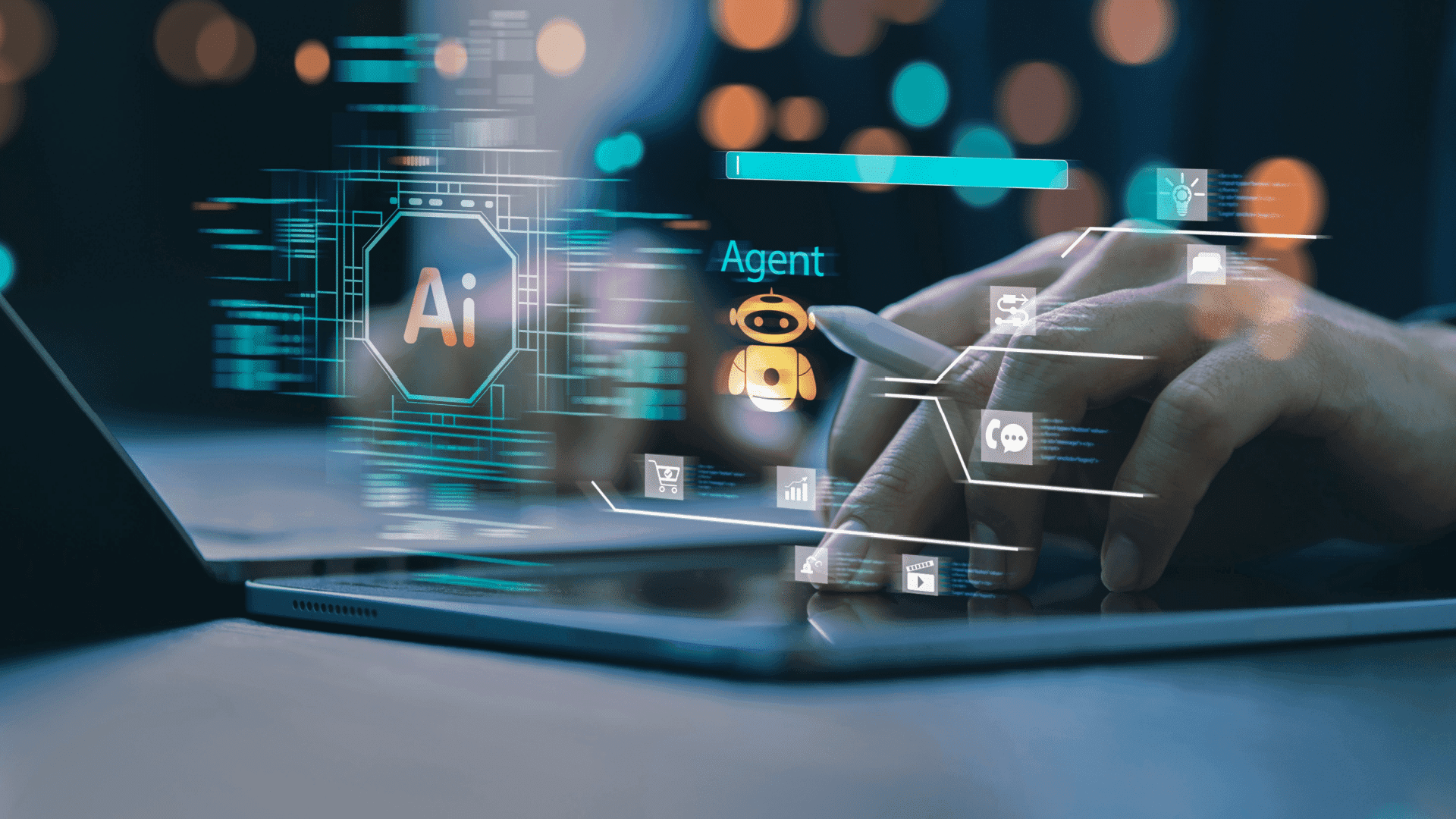
1. Natural Language Processing (NLP): Talk To The Agent Like A Teammate. Plain Language, Instant Insight
Natural language processing gives teams a conversational interface to the AI marketing agent. Users type or speak questions such as “Show ROAS by channel for last quarter,” and the agent:
Parses intent
Extracts entities
Maps terms to metrics
Converts the request into structured queries or SQL for your data warehouse
This lets non-technical staff run attribution, cohort, and funnel queries through a virtual agent without waiting for analysts. How would your SDR or campaign manager use conversational search to diagnose a drop in conversion rate?
2. Predictive Analytics: Forecast Performance And Act Before Patterns Harden
Predictive analytics uses historical and real-time:
Input to project trends
Estimate future conversion rates
Surface risks like:
Rising churn
Ad fatigue
The agent applies time series models, propensity scoring, and scenario simulation to provide probability ranges and suggested levers, such as shifting the budget or changing creative.
These forecasts feed:
Campaign optimization
Customer lifetime value modeling
Audience prioritization
Teams can move from reactive fixes to proactive planning. What shift would you make if the model predicts a fall in ROAS next month?
3. Autonomous Decision Making: Let The Agent Execute Routine Moves So Your Team Focuses On Strategy
Autonomous decision-making combines machine learning models with encoded business rules to recommend or execute actions without manual approval when thresholds are met.
Use cases include:
Automated bid adjustments
Budget reallocation across channels
Real-time pause or scale of underperforming creatives
Enrollment of high intent leads into nurture flows
Built-in guardrails, audit logs, and human review gates preserve control while shortening time to action, and the agent can revert or escalate when confidence drops. Which routine decisions would you automate first to cut latencies?
4. Cross-Platform Orchestration: Coordinate Campaigns, CRM, And Analytics From One Control Plane
Cross-platform orchestration connects the AI agent to:
Ad platforms
Marketing automation
CRM
CDP
Analytics systems via:
APIs
Streaming connectors
The agent:
Pulls signals
Updates audience segments
Triggers activation
Syncs events
The campaign then change propagate across the martech stack.
This unified approach supports:
Omnichannel personalization
Consistent attribution
Closed loop measurement between:
Paid
Owned
Earned channels
Can you imagine turning a lead score change into an immediate email and ad adjustment?
5. Anomaly Detection: Spot Odd Behavior Fast And Get Context, Not Just An Alert
Anomaly detection monitors live performance feeds to detect sudden spikes or drops, like an unexpected rise in CPC or a fall in conversion rate.
The agent uses statistical tests and unsupervised models to:
Score anomalies
Surface likely causes
Prioritize incidents by business impact
Alerts include contextual signals such as:
Recent creative changes
Landing page errors
Bid strategy shifts
Triage starts with this evidence. How quickly could your team respond when an anomaly arrives with a clear root cause hint?
6. Custom Business Logic Integration: Make The Agent Follow Your Rules, Definitions, And KPIs
Custom business logic integration embeds your organization into the agent’s decision layer on specific:
KPIs
Attribution rules
Margins
Workflows
Your LTV, contribution margin, and internal scoring formulas become native inputs to forecasting, bidding, and reporting, so recommendations match how your company measures success. The agent supports rule engines, role-based access, and versioned logic, so changes are auditable and safe. What proprietary metric do you want the agent to optimize for?
7. Automated Reporting And Visualization: Deliver Dashboards And Briefings Tuned To Each Stakeholder Automatically
Automated reporting and visualization generate:
Tailored dashboards
Executive summaries
Operational views
It updates on demand or when triggers fire.
The agent:
Assembles visuals
Writes plain language commentary
Routes reports to:
Slack
Email
BI tools
These enable them to drill down for analysts.
Templates for campaign performance, channel attribution, and funnel health reduce manual reporting and make KPI tracking continuous. Who should get a daily brief that highlights only the anomalies and action items?
Top 16 AI Marketing Agent Tools and Platforms
1. AI Acquisition: Build And Scale Your AI-Powered Business Without The Busywork
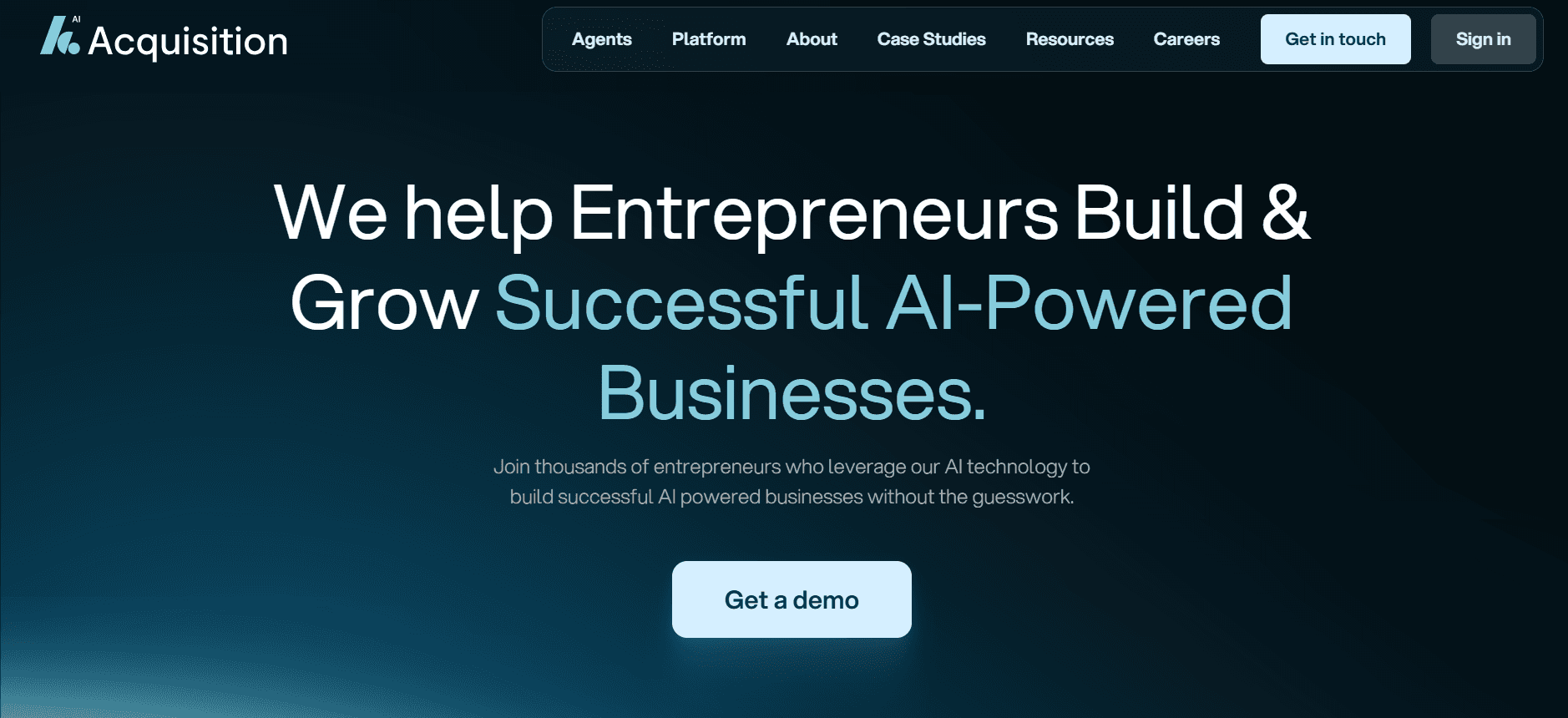
AI Acquisition helps entrepreneurs launch and run AI-driven companies using an agentic platform that automates lead generation, sales, and operations. Used by more than 1,200 founders, the platform reduces the need for large teams while keeping execution tight and measurable.
To keep prospecting and follow up running 24/7, the stack combines:
Autonomous AI agents
CRM integrations
Pipeline automation
Campaign orchestration
These capabilities focus on pipeline growth, meeting scheduling, and delivering human-quality results so founders can prioritize growth actions.
How Can AI Acquisition Support Your Marketing Goals?
Automate lead generation and appointment booking with persistent AI agents.
Scale sales outreach and operations without significant hires or manual processes.
Deliver consistent pipeline activity and measurable monthly revenue performance.
Integrate CRM and marketing channels for continuous campaign execution.
2. Chatsonic: The AI-Powered Assistant for Modern Marketers

Chatsonic, created by Writesonic, targets marketers who need reliable content production and up-to-date information. Writesonic, founded in 2020 by Samanyou Garg, built Chatsonic on GPT‑4 class models to make content faster and more relevant for digital teams. Chatsonic blends real-time web search, multi-format content support, and image generation so teams produce accurate copy, visuals, and audio without breaking workflow. Integrations with WordPress and SEO tools keep distribution and optimization efficient while preserving brand voice.
How Can Chatsonic Support Your Marketing Goals?
Keep content current with live web access and Google integration.
Produce visual assets from text to enrich campaigns.
Maintain consistent brand tone across channels.
Connect to WordPress and SEO tools for a smoother publish cycle.
3. Skott: All-in-One AI Content Marketing Partner
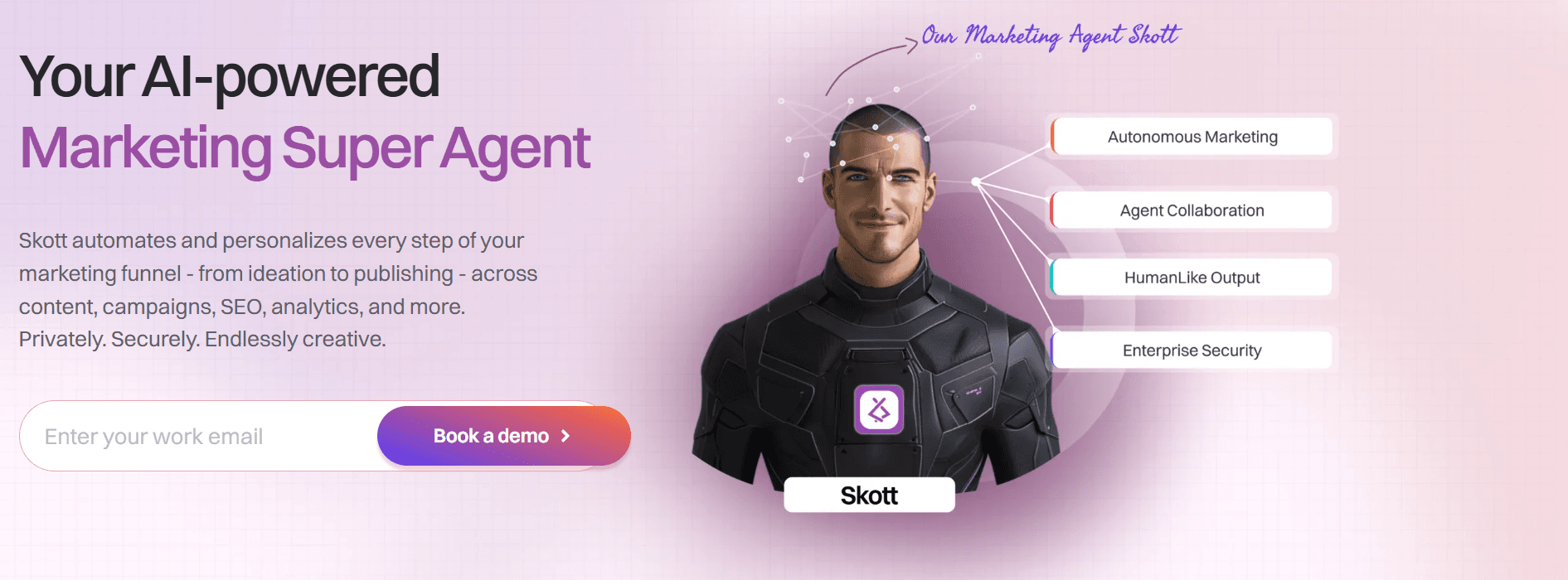
Skott, built by Lyzr AI, acts as an autonomous content marketer that:
Manages research
Creation
Distribution
It targets teams that need a constant stream of SEO optimized content and cross-channel repurposing without expanding headcount. Skott uses daily topic discovery, NLP-driven content generation, and multi-channel publishing to produce:
Blog posts
Social snippets
Audio
Video
A human in the loop ensures brand alignment while automation handles the repetitive production and scheduling work.
How Can Skott Support Your Marketing Goals?
Automate content production to keep channels active and consistent.
Discover and research topics daily to stay relevant and search-friendly.
Repurpose core content into formats for social, audio, and video.
Centralize control with review workflows and enterprise automation.
4. Anyword: AI-Powered Copywriting for Marketers
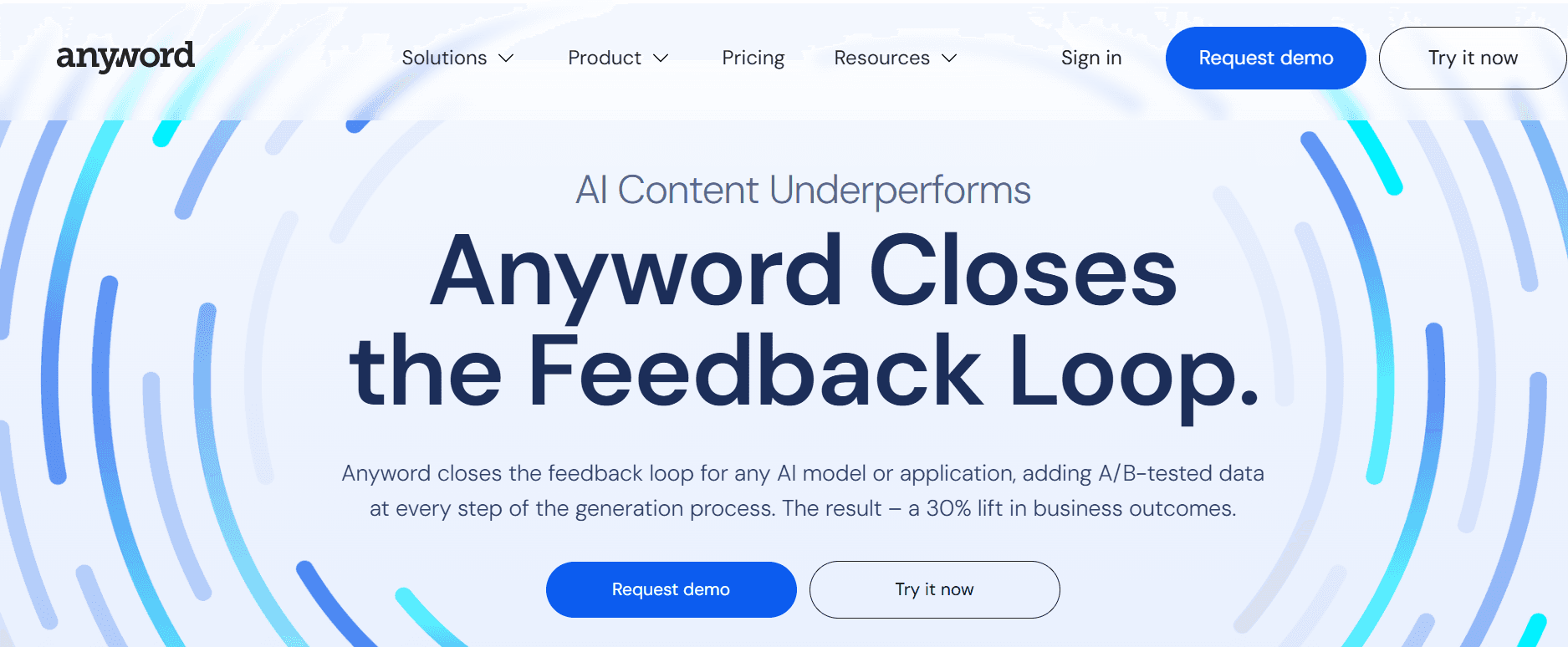
Anyword began as Keywee in 2013 and rebranded to focus on AI copy in 2021. The New York company offers copy generators tuned to marketing outcomes to speed writing and improve performance. It applies predictive performance scoring, brand voice modeling, and hundreds of marketing templates to produce:
Landing pages
Ads, emails
Social copy
The platform supports global campaigns with 30 plus languages and optimization tools for conversion -ocused messaging.
How Can Anyword Support Your Marketing Goals?
Generate targeted copy for ads, email, and landing pages.
Predict engagement and conversion with performance scoring.
Use templates to reduce drafting time and A/B test variations.
Keep messaging consistent across languages and campaigns.
5. Synthesia: Revolutionizing Video Content Creation
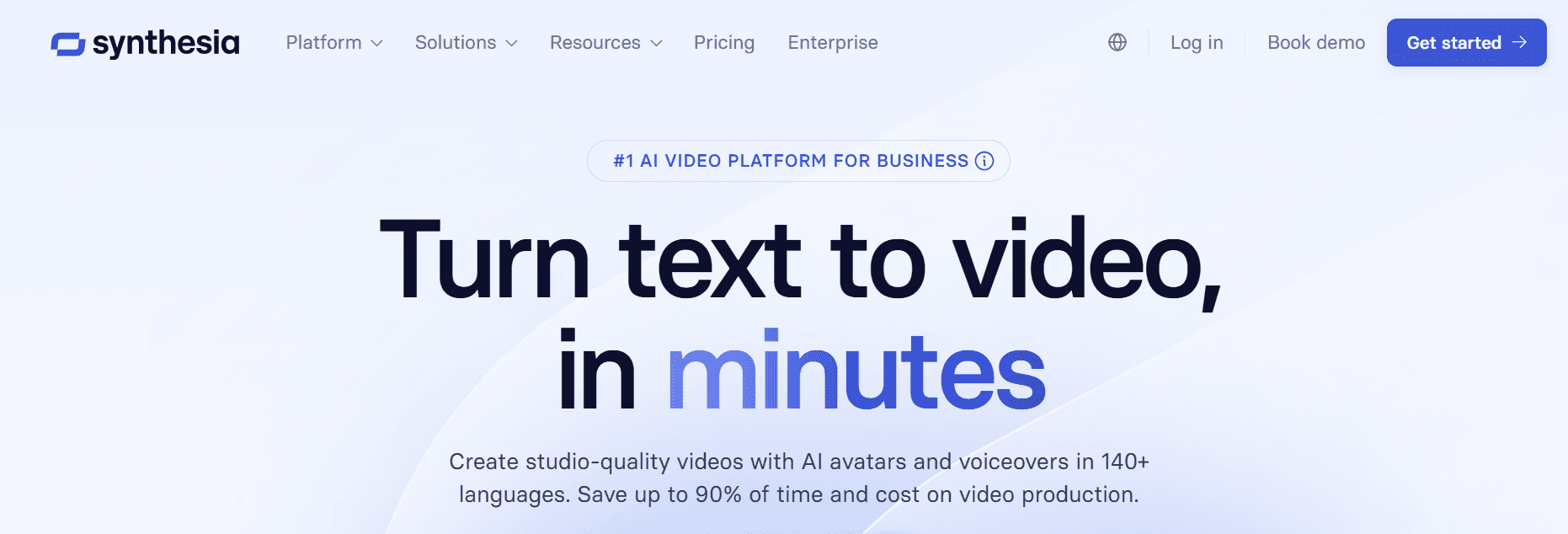
Synthesia, founded in 2017, provides AI-generated video avatars for communications and marketing without cameras or studios. The London-based company solves video production slowdowns for distributed teams.
The platform:
Converts text to lifelike video using synthetic presenters
Supports more than 140 languages
Offers 240 plus avatars plus custom avatar creation
Templates speed recurring updates, allowing rapid edits by changing the script rather than reshooting.
How Can Synthesia Support Your Marketing Goals?
Produce professional videos from text quickly and at lower cost.
Localize video messaging across languages with a consistent brand voice.
Pick or create avatars to represent brand identity.
Update content fast by editing scripts instead of re-filming.
6. Omneky: AI-Driven Advertising for Personalized Campaigns
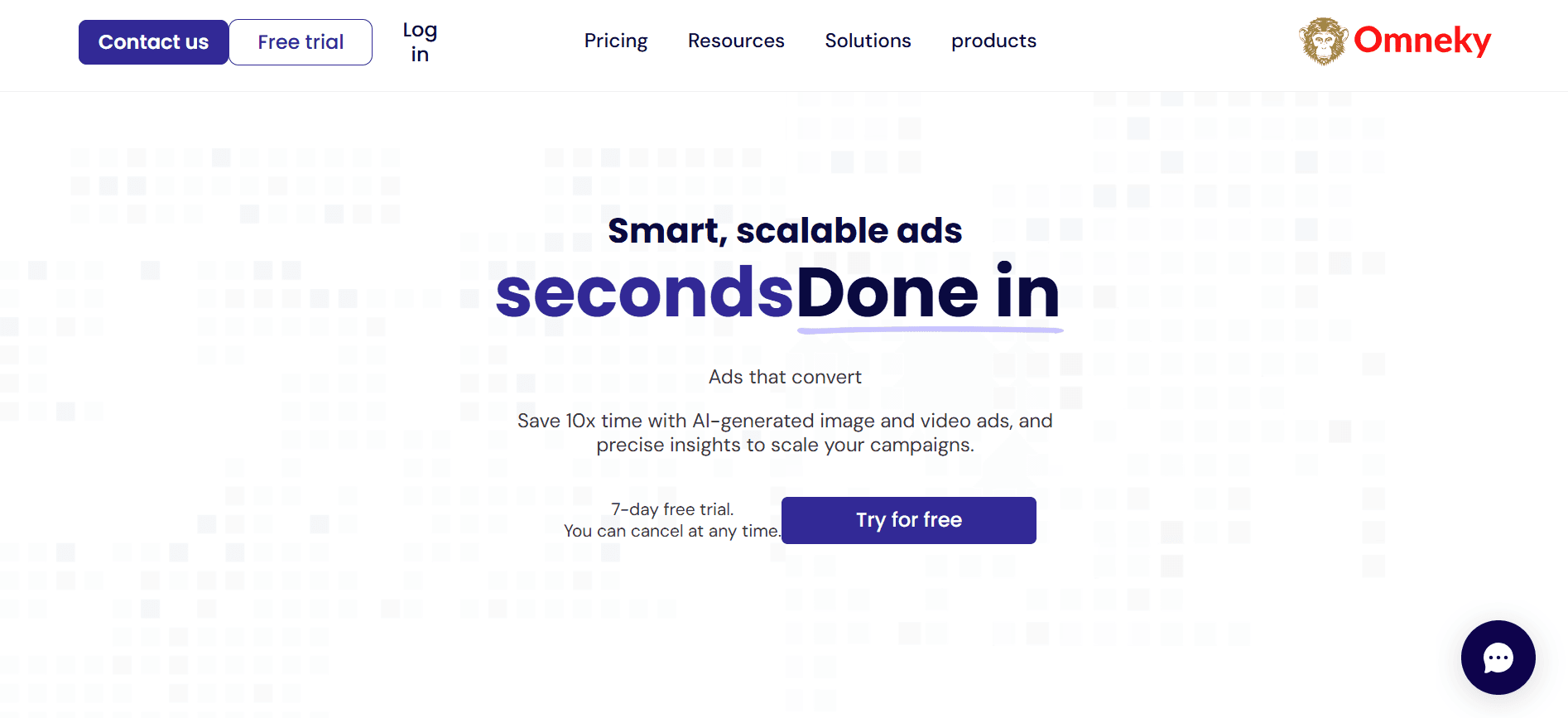
Omneky, founded in 2018 by Hikari Senju, uses machine learning to scale ad creative testing and personalization. The platform targets marketers who need faster creative iterations and better audience fit. It analyzes performance data and audience signals to produce personalized creatives and optimize placements. Omneky centralizes omnichannel campaign management to keep these factors aligned:
Creative
Targeting
Measurement
How Can Omneky Support Your Marketing Goals?
Auto-generate ad creatives tailored to audience segments.
Continuously test and optimize creatives with performance analytics.
Run omnichannel campaigns from a single control plane.
Preserve brand consistency across ad variations.
7. RTB House: Precision Advertising Through Deep Learning
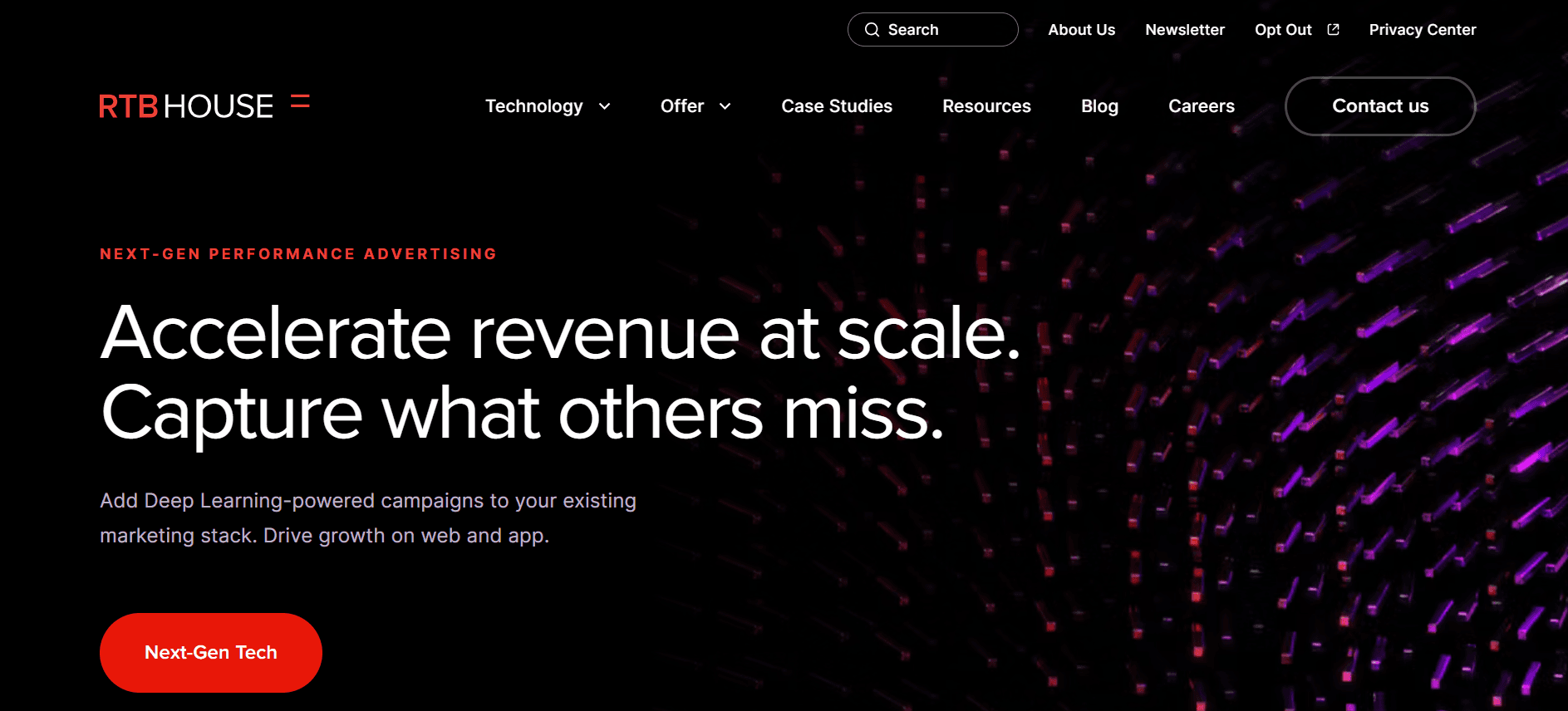
RTB House, founded in 2013, offers programmatic advertising with deep learning models focused on retargeting and conversion. The Warsaw-based firm serves global advertisers that demand precise bidding and audience prediction.The system applies proprietary deep neural networks to bidding and personalization, enabling efficient real-time bidding and accurate consumer targeting. Reporting and analytics reveal where spend drives conversions so teams can scale efficiently.
How Can RTB House Support Your Marketing Goals?
Use deep learning to optimize programmatic bids and placements.
Target high-value audiences with precise retargeting.
Access real-time bidding for efficient media buying.
Measure and refine campaigns with detailed analytics.
8. Pega GenAI: Customer Engagement with Generative AI

Pega GenAI, rolled out in Q3 2023 by Pegasystems, embeds generative AI into the Pega Infinity platform to speed engagement and automation for enterprises. It suits companies that need faster case resolution and smarter agent support.
Pega GenAI generates:
Summaries and contextual guidance
Creates content for outreach
Automates workflow generation in a low-code environment
The result is faster application development and more personalized customer interactions.
How Can Pega GenAI Support Your Marketing Goals?
Auto-generate agent guidance and conversation summaries.
Build customer journeys and workflows with low-code prompts.
Personalize messaging and campaigns with generative content.
Free teams from routine tasks so they focus on strategy and quality.
9. HubSpot: Enhanced Customer Engagement
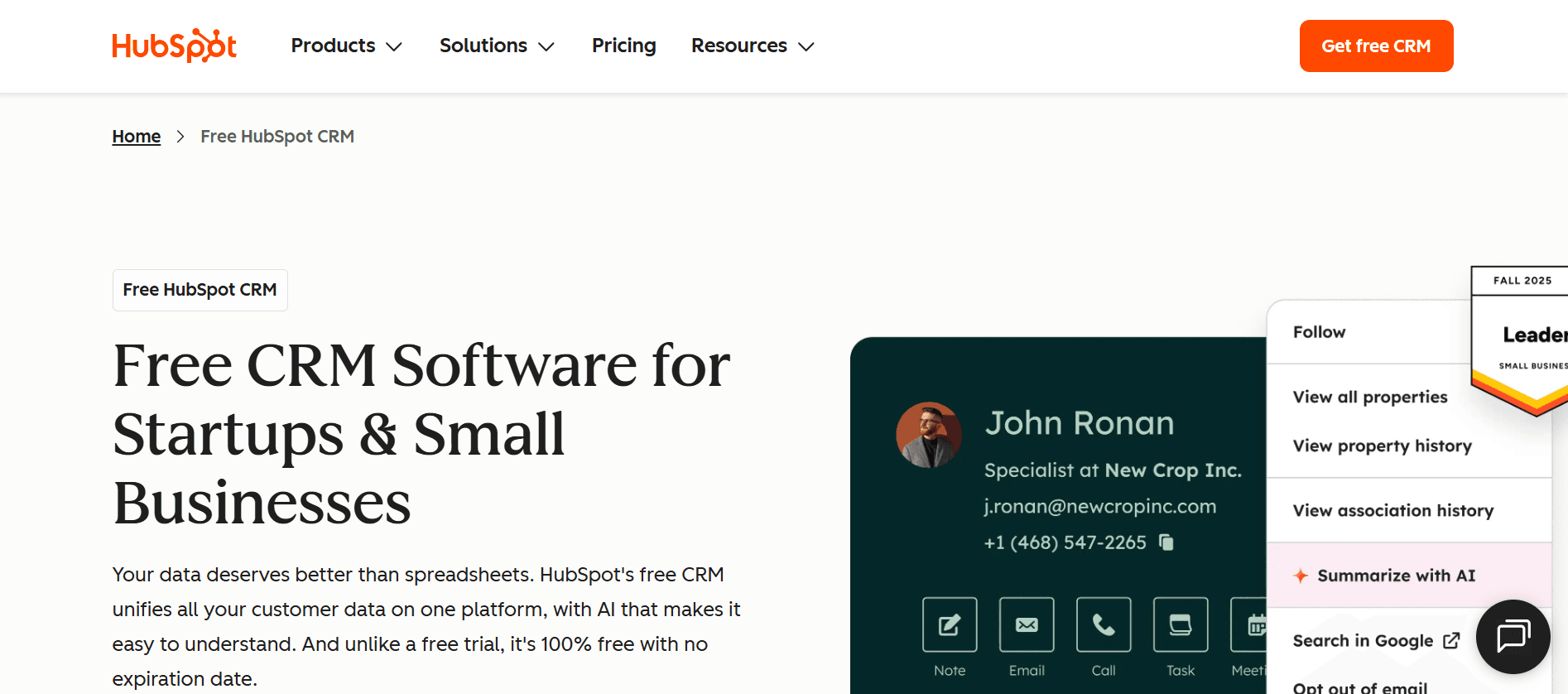
HubSpot, founded in 2006, combines CRM, marketing automation, and CMS to scale inbound strategies.
Breeze, HubSpot’s generative AI assistant, helps teams:
Write content
Draft emails
Shape campaigns faster
HubSpot’s AI features streamline:
Copy creation
Personalize emails
Automate routine interactions with chatbots
Teams gain a unified view of contacts, which supports:
Segmentation
Personalization
Analytics in one platform
How Can HubSpot Support Your Marketing Goals?
Create content faster with AI-assisted copywriting tools.
Personalize outreach at scale with automated email generation.
Automate customer interactions using AI chatbots.
Analyze campaign performance with integrated AI insights.
10. Zapier Agents: AI Automation Across 7,000+ Apps
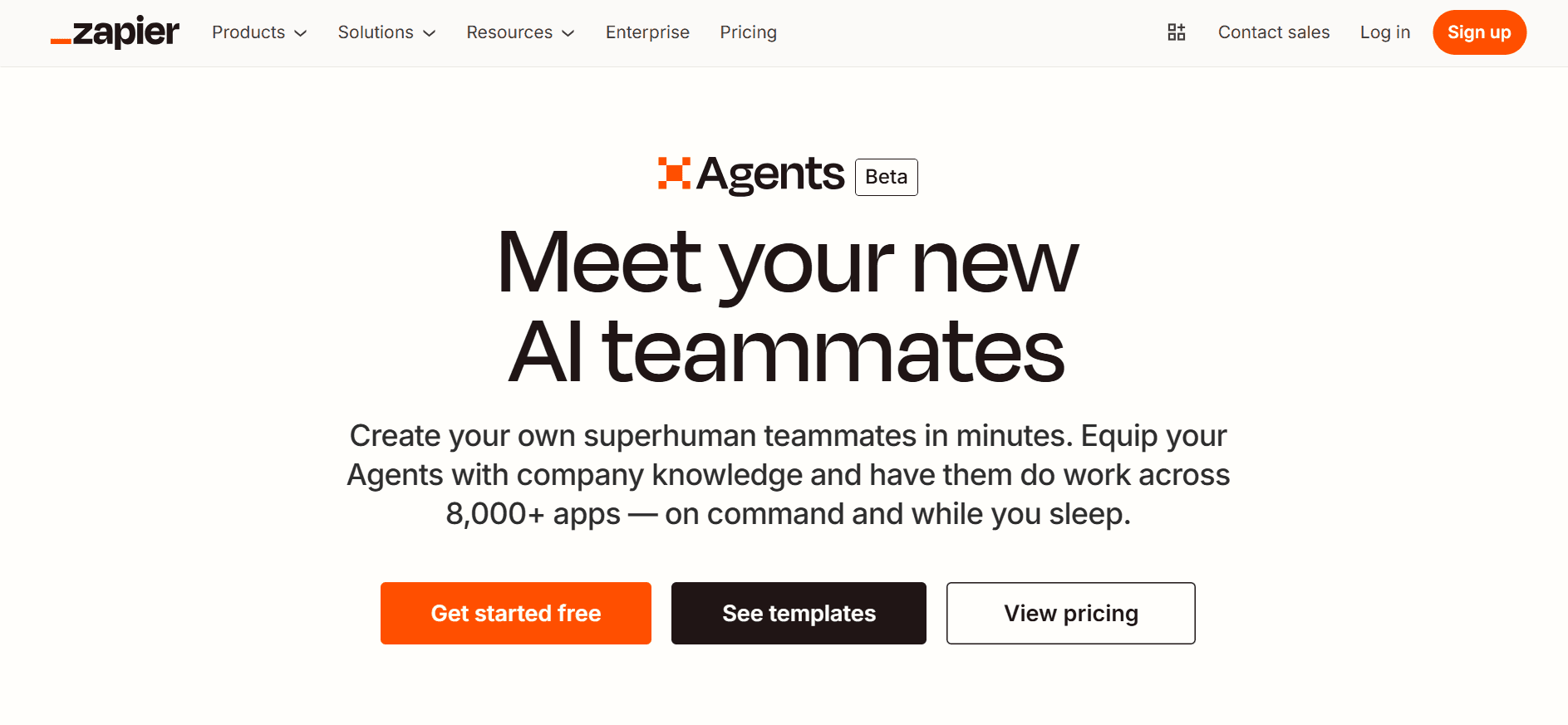
Zapier, founded in 2011, added AI Agents in 2024 to let teams build natural language-driven assistants that operate across thousands of apps. The platform targets operations and marketing teams that need cross-system automation without code.
Agents perform:
Background tasks
Act on live business data
Connect tools like:
HubSpot
Google Sheets
Meta Ads
Slack
These agents automate:
Lead routing
CRM updates
Email responses
Reporting workflows
How Can Zapier Agents Support Your Marketing Goals?
Build agents with natural language instead of code to automate workflows.
Orchestrate actions across CRMs, ad platforms, and collaboration tools.
Execute real-time routing and updates using live data.
Remove manual repetition from reporting and CRM maintenance.
11. Lucy: Your AI-Powered Marketing Brain
Lucy, created by Equals 3 in 2015, indexes internal knowledge so marketing teams can search across campaigns, decks, asset libraries, and research. It is aimed at enterprises that need quick access to tribal expertise and past work. By connecting to DAMs, CRMs, cloud drives, and document stores, Lucy surfaces existing assets. She reduces duplicated efforts: teams access campaign archives and research through natural language queries for faster decision-making.
How Can Lucy Support Your Marketing Goals?
Search across documents and campaign assets with plain language.
Surface prior work and research to avoid duplication.
Break down silos so teams reuse proven content and insights.
12. Cursor: AI Native Code Editor for Technical
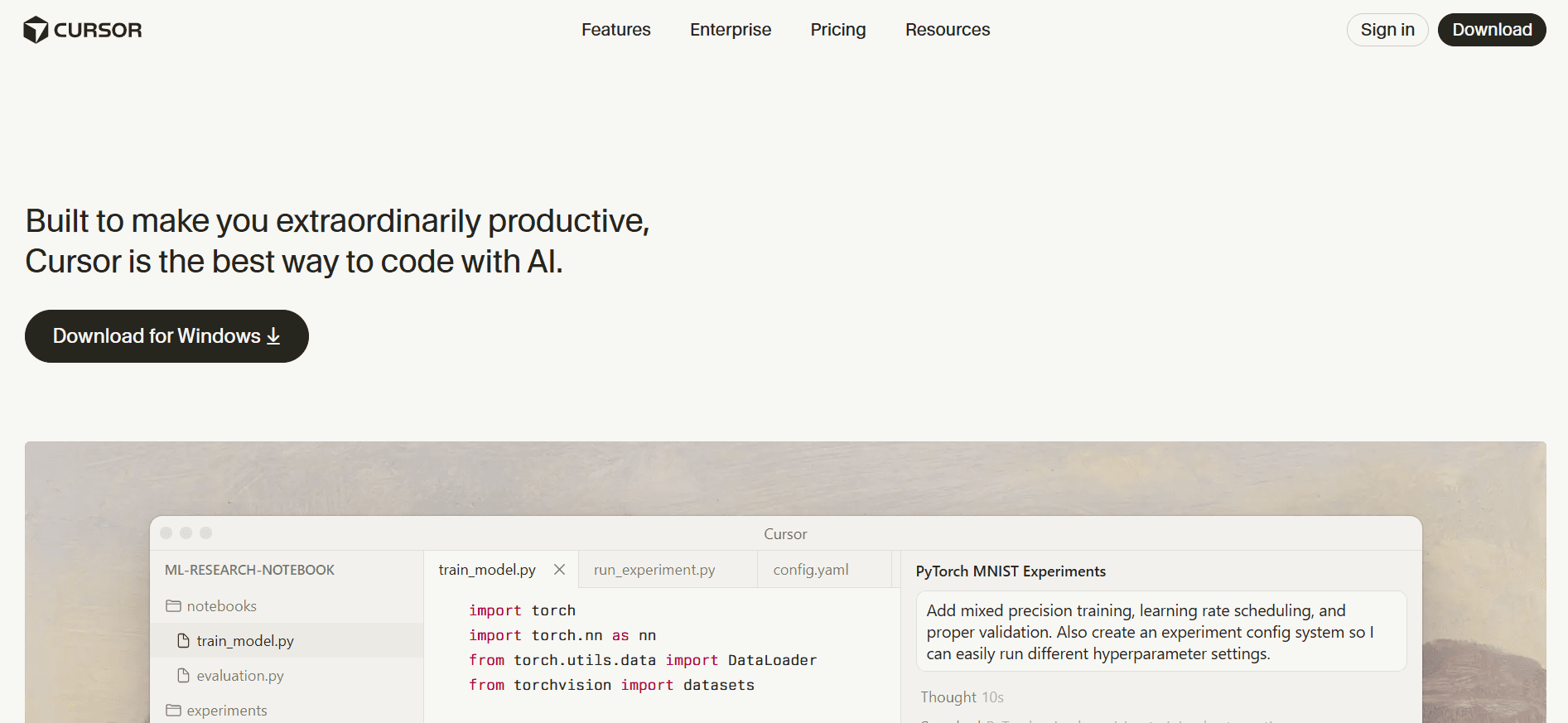
Marketers
Cursor, built by Anysphere in 2022, functions as an AI-assisted IDE that predicts next steps, debugs, and applies complex edits inside a custom environment.
It suits technical marketers who manage code for:
Analytics
Automation
Integration
Cursor leverages GPT and Claude class models to:
Complete code
Refactor
Run context-aware edits
The editor speeds tasks like tracking scripts, automation code, and analytics tags while supporting VS Code extensions and developer workflows.
How Can Cursor Support Your Marketing Goals?
Write and refactor code using natural language prompts.
Predict next steps and complete chunks of code for faster delivery.
Search large codebases with plain language to find integrations.
Integrate with developer tools and workflows out of the box.
13. Assistents.ai: No Code AI Agents for Marketing Workflows
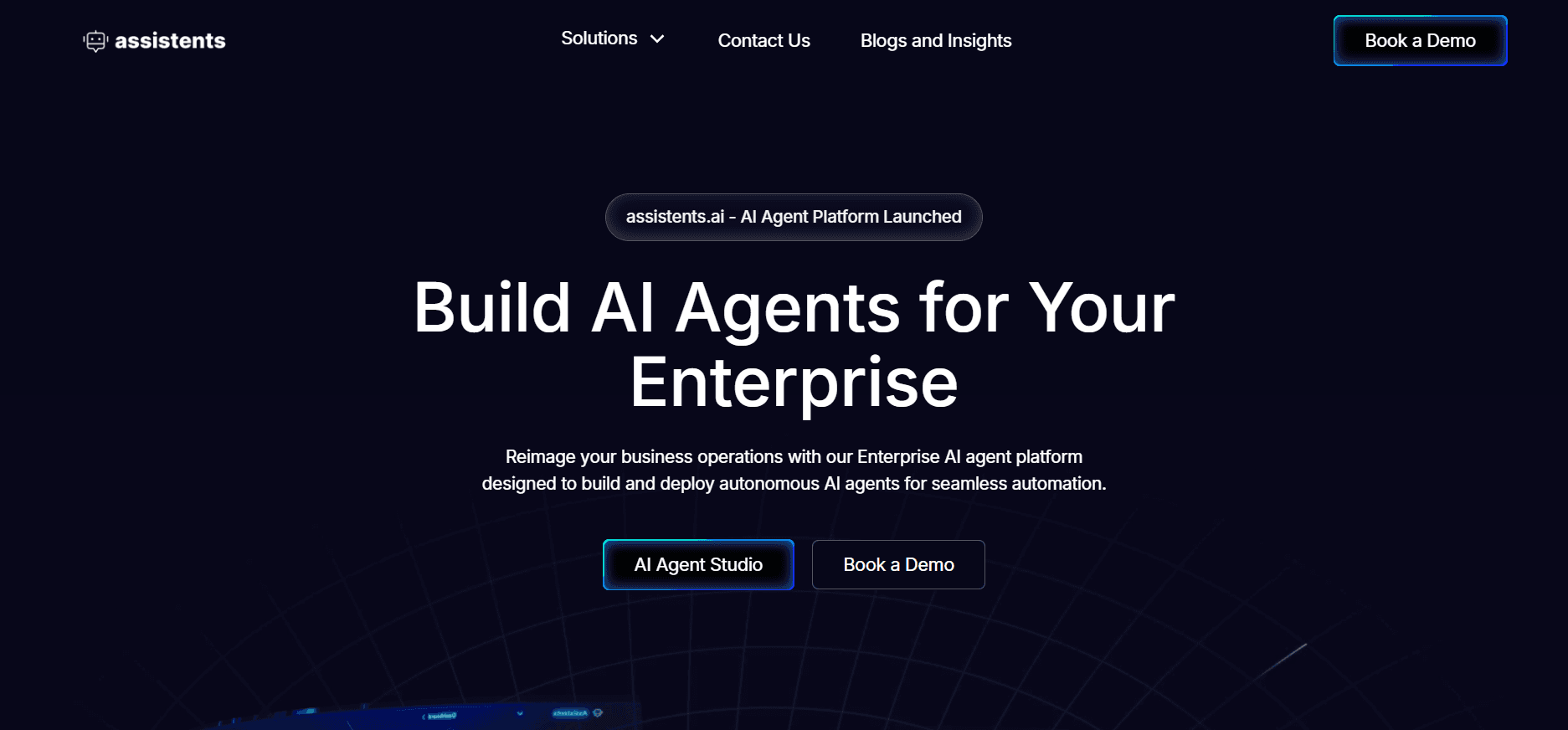
Assistents.ai offers a conversational code platform to build AI agents for:
Email
Lead scoring
Ad optimization
Competitor tracking
Marketers get templates and ready to deploy agents without deep development work.
The platform supports multi-agent systems and omnichannel automation by integrating with CRMs and marketing stacks. Agents run in cloud or local environments and process real-time data for accurate scoring and personalization.
How Can Assistents.ai Support Your Marketing Goals?
Build no-code AI agents with templates for common marketing tasks.
Deploy multi-agent workflows for complex funnels and follow-ups.
Integrate with CRM and ad platforms for unified automation.
Process real-time data to improve scoring and personalization.
14. Opal by Optimizely: AI Agents Inside Your DXP
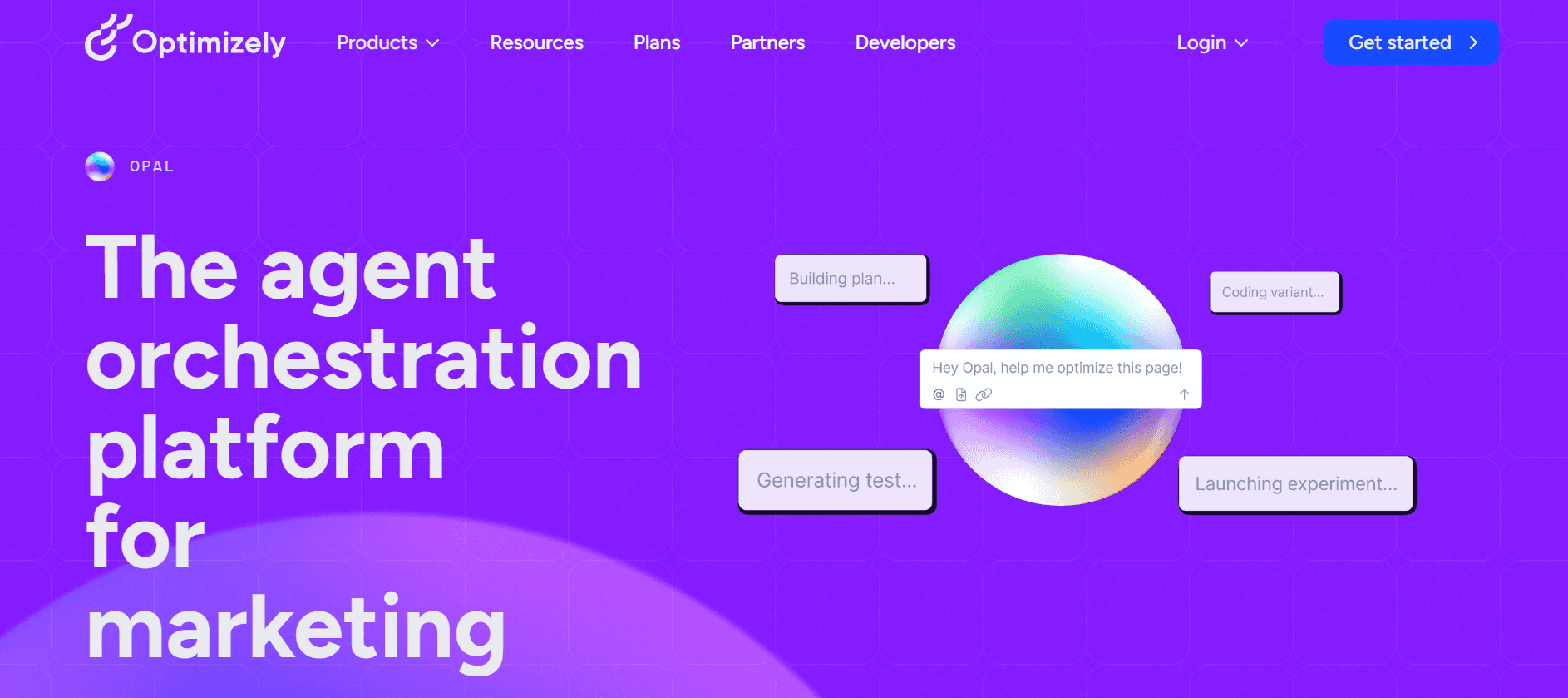
Opal embeds AI marketing agents into Optimizely to:
Drive ideation
Experiment analysis
Campaign automation
The feature set helps teams that run experiments and personalization from a digital experience platform.These agents use Google’s Gemini models to pull organizational data, create on-brand copy and visual assets, and analyze user-level behavior for segmentation. Playbooks guide deployment so the agents act in consistent ways across projects.
How Can Opal Support Your Marketing Goals?
Generate campaign ideas and copy within Optimizely.
Automate experiment analysis and surface winning variants.
Create on-brand visuals and copy for ads and landing pages.
Use real-time user attributes to drive personalized experiences.
15. Akira AI: Autonomous Marketing Agents for Rapid Execution

Akira AI delivers agentic automation and autonomous agents that:
Monitor campaigns
Adjust targeting
Generate branded content in real time
The system targets marketers who require fast decision cycles and scalable execution.
Akira blends LLMs from OpenAI, Google, Llama, Mistral, and Anthropic with an Ops engine that orchestrates multi-agent workflows.
Agents learn from:
Feedback
Integrate with CRM and ITSM systems
Execute predictive analytics and campaign optimization
How Can Akira AI Support Your Marketing Goals?
Run autonomous campaign optimization and real-time targeting adjustments.
Generate branded content and personalized messaging at scale.
Use predictive analytics for smarter budget and channel decisions.
Integrate with CRMs and enterprise systems to automate ops.
16. Botpress: Build Custom AI Marketing Agents at Scale
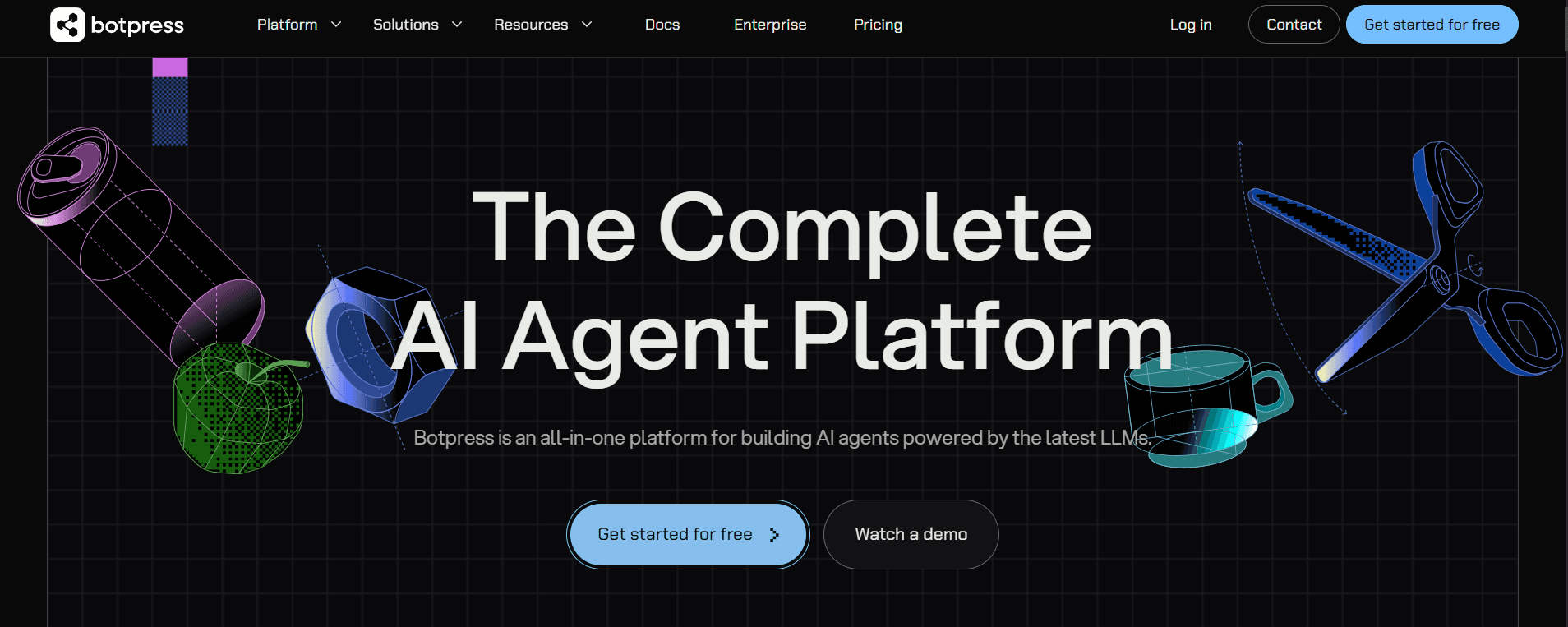
Botpress offers a modular platform for building marketing agents that handle:
Onboarding
FAQs
Appointment booking
Lead qualification
It appeals to SaaS and e-commerce teams that need customizable conversational AI and document-driven agents.
Botpress supports:
Multimodal LLMs
Imports data from PDFs and websites
Provides a drag-and-drop agent builder
With API and SDK access, teams create tailored workflows that update CRMs and trigger downstream marketing tasks.
How Can Botpress Support Your Marketing Goals?
Build conversational agents for lead qualification and support.
Pull knowledge from documents to keep responses accurate.
Use a visual builder to customize flows without heavy coding.
Monitor activity in real time and integrate with existing systems.
Numbered Reference List with Key Details
1. AI Acquisition
Ready to build and scale your AI-powered business without the complexity or massive teams? Join 1,200+ entrepreneurs using AI Acquisition's all-in-one agentic platform to automate lead generation, sales, and operations. Clients average $18,105 monthly revenue and the platform helped generate over $30 million this year. Get the free AI growth consultant and deploy a digital workforce of AI agents to fill your pipeline, book meetings, and deliver human-quality results while you focus on growth, not guesswork.
2. Chatsonic: The AI-Powered Assistant For Modern Marketers
Created by Writesonic, launched in 2020, uses GPT 4 and real-time web search.
Key features:
Live Google integration
Image generation
Multi-format content
WordPress
Ahrefs integrations
Use cases:
Keep content current
Generate visuals
Maintain brand voice
Publish across platforms
3. Skott: All-In-One AI Content Marketing Partner By Lyzr AI
Autonomous content creation, daily topic research, SEO optimized posts, repurposing into text, image,s audio, and video. Manages 20+ channels and offers the loop review. Saves time on research and scales marketing operations.
4. Anyword: AI-Powered Copywriting For Marketers
Founded as Keywee in 2013, rebranded in 2021.
Offers:
Predictive performance scoring
100+ templates
Brand voice tools
Support for 30+ languages
Use for:
Ads
Emails
Landing pages
Localized campaigns
5. Synthesia: Revolutionizing Video Content Creation
Founded in 2017 in London.
Create realistic video avatars:
Without filming
Supports 140+ languages
240+ avatars
Template-based editing for fast updates
6. Omneky: AI-Driven Advertising For Personalized Campaigns
Founded in 2018, uses machine learning for:
Ad creative generation
Testing
Optimization
Centralizes omnichannel campaign management and creative personalization to boost ROI.
7. RTB House: Precision Advertising Through Deep Learning
Founded in 2013 in Warsaw. Specializes in retargeting and real-time bidding with proprietary deep learning models and global operations across 30+ markets.
8. Pega Genai: Customer Engagement With Generative AI
Launched Q3 2023 by Pegasystems.
Integrates generative AI into:
Workflow automation
Customer summaries
Low-code app generation
Engagement optimization
9. Hubspot: Enhanced Customer Engagement
Founded in 2006. Breeze generative AI helps with:
Content creation
Email personalization
Campaign support
Chatbots
Integrated analytics across:
The CRM
Marketing stack
10. Zapier Agents: AI Automation Across 7,000+ Apps
Founded in 2011, introduced AI Agents in 2024.
Agents automate cross-platform workflows with:
Natural language
Touching HubSpot
Google Sheets
Meta Ads
Slack and more
11. Lucy: Your AI-Powered Marketing Brain
Created in 2015 by Equals 3. Knowledge management that searches documents, decks, databases, DAMs, and CRMs with natural language, reducing duplicated work and surfacing existing content.
12. Cursor: AI-Native Code Editor By Anysphere
Founded in 2022. Predictive code editing, debugging, and autonomous code execution inside a custom IDE using GPT and Claude models. Supports VS Code integrations.
13. Assistents.ai: Conversational Code Platform For Marketing Agents
No code agent builder, ready to:
Deploy blueprints
Multi-agent workflows
Omnichannel integration
Real-time data processing
One-click deployment to cloud or local
14. Opal By Optimizely: AI Agents Embedded In A DXP.
Uses Google Gemini to:
Pull Optimizely data
Supports campaign ideation
Experiment analysis
User-level profiling
Asset generation
Includes AI playbook and integrations with cloud providers.
15. Akira AI: Agentic Automation For Marketing
Autonomous agents for:
Email
Digital marketing
Predictive analytics
Brand monitoring
Campaign optimization
Uses LLMs from OpenAI, Google Llama, Mistral, Anthropic, and an ops engine for multi-agent orchestration.
16. Botpress: Scalable AI Marketing Agents For Saas Education And eCommerce
Multimodal LLM support
Data import from PDFs and websites
Drag and drop builder
API and SDK access
Real-time monitoring
Build agents for onboarding, FAQ resolution, appointment scheduling and CRM updates.
Related Reading
• AI Media Buying
• AI Sales Forecasting
• AI Agent Use Cases
• Automated Cold Calling
• AI Agent Implementation Business Benefits
• AI Agent vs Chatbot
How to Integrate Your First AI Marketing Agent?

Pinpoint The Win: Define Objectives And Measurable KPIs
Choose one high-impact use case where an AI marketing agent can move the needle.
Examples:
Anomaly detection in:
Paid media spend
Predictive lead scoring
Audience expansion for lookalike campaigns
Automated creative testing
For each use case, state the primary KPI in exact terms, for example reduce wasted ad spend by X percent per month, lift qualified leads by Y percent, or cut cost per acquisition from $A to $B. Set a baseline window and measurement method now so you can compare agent performance against real numbers later.
Ask this: What metric will tell us the agent worked without debate.
Map The Data Highway: Audit Data Quality And Integration Points
List every data source the agent needs.
Typical items:
Marketing data warehouse
CRM
Ad platform APIs
Web analytics
Email platform
Attribution store
First-party behavioral logs
Assess data reliability by each:
Source
Record freshness
Schema
Identifier keys
Historical depth
Flag gaps such as:
Missing conversion timestamps
Inconsistent UTM tagging
Fragmented customer IDs
Build an integration map that shows where the agent will:
Read and write
Capture API rates
Auth methods
Latency limits
To standardize event names and revenue attribution, add a simple data checklist:
Must-have fields
Enrichment needs
A plan
Select The Right Agent Mode: Insight, Semi-Autonomous, Or Fully Autonomous
Decide how much autonomy you will grant the agent. Insight-only agents suggest actions and surface anomalies. Semi-autonomous agents propose changes but require human approval before execution. Fully autonomous agents act on rules and thresholds and push changes directly into ad platforms or CRM. Match agent mode to risk tolerance and governance. If compliance or brand safety matters, start with insight or semi-autonomous. If you need scale and speed and have tight guardrails, move toward autonomy for narrow tasks like bid adjustments or budget reallocation.
Encode Business Logic And Compliance Rules: Build Rules The Agent Must Obey
Convert internal definitions into code and constraints.
Define:
Conversion events
Attribution windows
ROI formulas
Allowable bid ranges
Spend caps by channel
Encode privacy constraints and consent states so the agent never use data where policy forbids. Add explainability requirements such as why a score changed or why a budget moved. Store logic in a versioned policy file or rules engine so audits and rollbacks are simple. Include regulatory checks for GDPR, CCPA, and any industry-specific rules before the agent touches production systems.
Pilot In A Contained Channel: Start Small And Controlled
With enough volume to measure effects:
Pick one channel
Campaign type
Geography
Use canary deployments or a shadow mode where the agent runs in parallel and logs decisions without changing live settings. Validate outputs against human analyst judgment over a 2 to 6 week window. Run A/B tests where a control group stays human-driven and the treatment group follows agent recommendations with approval gates.
Track both business KPIs and model-level metrics such as:
Precision
False positive rate
Prediction latency
Drift indicators
Design Guardrails And Rollback Paths: Reduce Risk While Testing
Define explicit commit criteria to push agent changes live.
Use feature flags, time-based limits, and minimum data thresholds before the agent acts.
Implement automatic rollback triggers for negative outcomes like increased spend without lift or conversion drops beyond a preset threshold.
Keep a human in the loop for exceptions and unexpected creative or messaging changes.
Log every decision with context, input features, and a confidence score so postmortems can isolate root causes quickly.
Assign Ownership And Feedback Loops: Who Owns The Agent And How Will It Learn
Appoint a dedicated owner responsible for:
Output review
Feedback collection
Retraining cadence
Create a feedback workflow where:
Analysts label examples
Flag bad suggestions
Report false positives
Feed both quantitative signals like conversion lift and qualitative notes from campaign managers back into model retraining.
Set:
Retraining triggers by time
Concept drift detection
Performance decay
Require monthly reviews at first and tighten or relax cadence as stability grows.
Instrument Monitoring And Observability: Watch The Agent In Production
Build dashboards that show, in near real-time:
Agent actions
Impact on KPIs
Model health
To spot drift:
Monitor throughput
API errors
Data freshness
Feature distributions
Track business-level alerts such as:
Spend spikes
CTR drops
Conversion anomalies
Capture audit logs with user IDs, timestamped decisions, and the exact rule or model version that executed. Add anomaly detection on the agent itself so you learn before campaigns lose money.
Define Security, Privacy, And Access Controls: Protect Data And Reputation
Limit the credentials the agent uses and apply least privilege for API keys. Encrypt data at rest and in transit. Mask or tokenize PII before feeding it to the model where possible. Maintain a data retention policy and delete or archive training data per legal requirements. Record who can approve autonomous actions and require multi-person signoff for expanding autonomy levels or changing scoring thresholds.
Create Playbooks And Standard Operating Procedures: Make Behavior Repeatable
Write clear playbooks for common scenarios:
Approving a recommended budget shift
Responding to a sudden spend spike
Reverting a campaign change
Include:
Decision trees
Required approvals
Escalation paths
Communication templates for stakeholders
Train operations staff on these SOPs with tabletop exercises and simulated incidents.
Measure Impact With Controlled Experiments: Prove The Agent Delivers ROI
Run controlled experiments and incremental lift tests rather than relying on anecdote. Use holdout audiences or geo splits to measure incremental conversions and spend efficiency. Calculate ROAS, incremental lift, and cost per action changes against the baseline you recorded. Report results with confidence intervals and effect sizes so stakeholders see the magnitude and statistical significance of change.
Manage Model Lifecycle: Retraining, Versioning, And Retirement
Version models and policies.
Keep a catalog of:
Dataset versions
Feature engineering steps
Hyperparameters
Evaluation metrics
Set retraining triggers and maintain a rollback plan if a new version underperforms. Decommission models that no longer receive quality labels or that show persistent bias or drift.
Scale Rigorously: Expand Scope And Automate Repeatable Tasks
After pilots prove stable, add:
More channels
Audience segments
Campaign types incrementally
Move low-risk actions to fully autonomous mode first, like pausing underperforming ads at pre-approved thresholds. Continue human oversight on high-risk areas such as creative changes or brand messaging. Automate routine tasks that deliver consistent gains so teams focus on strategy and creative direction.
Optimize Team Structure And Skills: Who You Need On Board
Assemble a cross-functional squad:
A product owner
Data engineer
ML engineer
Marketing analyst
Legal or compliance advisor
Train campaign managers on interpreting model outputs and filing feedback. Create a shared glossary of metrics and event definitions so everyone speaks the same language.
Prepare For Drift And Edge Cases: Expect Surprises And Plan Response
Monitor feature distribution changes and seasonal effects that break models. Keep a fast path for analysts to flag and quarantine bad predictions. Maintain synthetic tests and replay pipelines that simulate worst-case scenarios before applying a new model version to live traffic.
Report And Communicate: Keep Stakeholders Informed
Produce short operational reports that show:
Actions taken
Tests run
Business impact in numbers
Use visualizations for trend changes and list active guardrails and incidents. Hold regular demos of the agent’s decisions so teams build trust and provide timely feedback.
Budgeting And ROI Tracking: Make The Finance Case
Estimate implementation costs across:
Data engineering
Model development
API usage
Human oversight hours
Project expected gains from baseline KPIs and calculate payback period and net present value for scenarios where the agent improves conversion rates or reduces wasted spend.
Legal And Ethical Review: Protect The Brand And Users
Run a legal review for:
Data usage
Consent
Algorithmic fairness
Document decision criteria and keep an auditable trail for regulators or auditors. Add human override capability for any decision that might harm customer trust or contravene policy.
Operational Checklist: Practical Items To Complete Before First Live Change
Baseline KPIs and measurement windows documented
Integration map with auth, rate limits, and data schemas
Data cleansing and standardization are complete for required fields
Rules engine with versioned business logic in place
Pilot plan, control groups, and A/B test design ready
Monitoring dashboards and rollback triggers implemented
Owner and SOPs assigned with training scheduled
FAQ Pause: Quick Answers To Common Beginner Questions
How much data do I need to start?
Answer: Start with enough volume to detect signal against noise for your KPI. If you lack data, begin with rules-based automation and add a model when the dataset supports reliable predictions.
When do I let the agent act autonomously?
Answer: Only after a consistent positive lift in controlled experiments and stable model behavior across metrics such as precision, recall, and drift.
How do I prevent the agent from amplifying bad signals?
Answer: Enforce strict guardrails, require minimum confidence thresholds, and keep manual approval for novel actions until the system proves reliable.
Ready Checks Before Broad Rollout
Confirm:
Audit logs are complete
Approvals and access controls are enforced
The owner can pause or rollback changes instantly
Make sure stakeholders agree on success metrics and a continuous improvement plan is scheduled.
Related Reading
AI Agent for SEO Strategy
Get Access to our AI Growth Consultant Agent for Free Today
Join 1,200-plus entrepreneurs using AI Acquisition, an all-in-one agentic platform that automates lead generation, sales, and operations. Our clients average $18,105 in monthly revenue and have generated over $30 million this year using the software. Get access to a free AI Growth Consultant and see how a digital workforce of AI agents can run 24/7 to fill your pipeline, book meetings, and deliver human-quality results while you focus on growth, not guesswork. Want to see how this fits your business model?
How Our Agentic Platform Runs Revenue Operations End-to-End
The platform coordinates autonomous agents that act like virtual sales reps and AI marketing agents.
They run:
Cold outreach
Sequence emails
Handle multi-channel engagement
Manage chat and voice conversations
Book meetings into your calendar
Each agent links to your CRM for pipeline management and uses predictive analytics to prioritize leads.
To optimize conversion rates and cost per lead, you get:
Workflow automation
Campaign orchestration
Real-time performance signals
What The Digital Workforce Actually Does Around The Clock
AI agents handle tasks that normally need a human team:
Prospect research
Intent detection
Personalization of messages
Follow up
Objection handling
Meeting confirmation
Natural language processing produces human-quality replies and conversational AI keeps outreach timely and relevant.
To improve response rates over time, the system:
Scores leads
Routes high-value prospects to live reps
Runs A/B tests on messaging
How would uninterrupted outreach change your sales cadence?
Proof In The Numbers Contractors And Solopreneurs Can Trust
Over 1,200 users show that the platform scales across niches. Average client revenue sits at $18,105 per month, while the cohort has driven over $30 million this year through AI-driven outreach and conversion. Those figures come from AI sales assistants managing outreach at scale, intelligent automation trimming manual work, and ROI optimization through data-driven tweaks. Which metric would you want to improve first?
What The Free AI Growth Consultant Gives You Right Away
The consultant runs a quick diagnostic on:
Lead sources
Funnel gaps
Messaging
CRM flows
You get a prioritized playbook:
Where to deploy autonomous marketing agents
Which channels to ramp first
How to set up email sequencing and meeting scheduling
The consultant can also propose a pilot that maps to your revenue targets and timeline. Ready to request your free session?
Integration, Analytics, And Keeping Your Systems Working Together
AI Acquisition connects to:
Major CRMs
Calendars
Data sources via secure APIs
You get unified dashboards for campaign performance, predictive lead scoring, and behavior-based triggers that drive agent actions.
Use the analytics to:
Tune personalization
Adjust audience targeting
Deploy new outreach sequences without code
Would you like a walkthrough of how your tools would connect?
Who Benefits Most From A Digital Sales And Marketing Workforce
Founders and small teams who need scale without hiring large staffs see the biggest gains. Agencies use the platform to run client campaigns with consistent quality. B2B sellers and subscription businesses accelerate pipeline growth with automated meeting booking and intent-driven outreach.
eCommerce and service businesses use conversational bots and voice agents for qualification and sales. Which use case matches your current bottleneck?
Security Controls And Quality Guardrails For Human Quality Outcomes
We enforce data privacy, role-based access, and audit logs so sensitive lead data stays protected. Model guardrails reduce hallucination, and we add a human in the loop for high-risk replies and complex negotiations. Service level agreements and monitoring keep response quality steady while continual AI model updates improve accuracy. Do you want details on compliance and auditing?
How To Get Started And What To Expect In The First 30 Days
Kick off with the free AI Growth Consultant, run a short diagnostic, then launch a pilot focused on one channel or audience.
Expect:
Initial sequences in days.
Measurable pipeline lift in a few weeks.
Scaling once conversion signals are clear.
Training and playbooks come bundled so your team can manage agents and oversee performance without heavy engineering. Which team member would lead your pilot?


